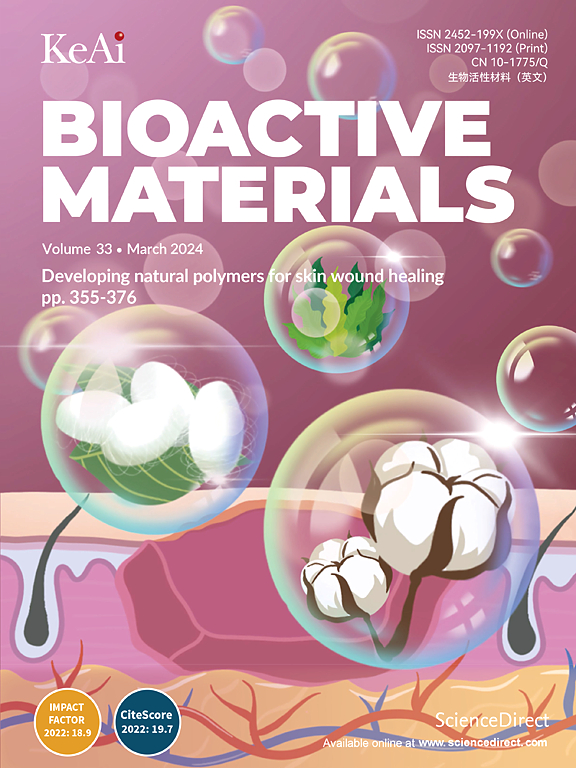“Monitor-and-treat” that integrates bacterio-therapeutics and bio-optics for infected wound management
IF 18
1区 医学
Q1 ENGINEERING, BIOMEDICAL
引用次数: 0
Abstract
Wound infections are one of the major threats to human health, accounting for millions of deaths annually. Real-time monitoring, accurate diagnosis, and on-demand therapy are crucial to minimizing complications and saving lives. Herein, we propose a “monitor-and-treat” strategy for infected wound management by integrating the emerging development of bacterio-therapeutics and bio-optics. The upper layer consists of gelatin methacryloyl (GelMA)-collagen III methacryloyl (Col3MA) (GC), Reuterin (Reu) isolated from the probiotic Lactobacillus reuteri (L. reuteri) and microfluidic safflower polysaccharide (SPS)@GelMA microspheres using 3D printing technology. The lower layer is made of acryloylated glycine (ACG) hydrogel with tissue adhesion capability, which enables the hydrogel to adapt to the movement and stretching of the skin. By integrating temperature-sensitive polydimethylsiloxane (PDMS) optical fibers, the ACG-GC/Reu/SPS-PDMS hydrogel could accurately and steadily sense and send wound temperature information to intelligent devices for real-time monitoring of the healing status (“monitor”). The double-layered hydrogel not only inhibited bacterial survival and colonization (97.4 % against E. coli and 99 % against S. aureus), but also exhibited remarkable hemostatic properties. Furthermore, it was conducive to L929 cell proliferation and pro-angiogenesis, and promoted the polarization of pro‐inflammatory M1 macrophages to the anti‐inflammatory M2‐phenotype, therefore creating a favorable immune microenvironment at the wound site. Animal experiments using SD rats and Bama minipigs demonstrated that this hydrogel promoted wound closure, directed polarization to M2 macrophages, alleviated inflammation, enhanced neovascularization, therefore accelerating infected wound healing (“treat”). In addition, RNA-Seq analysis revealed the mechanism of action of ACG-GC/Reu/SPS-PDMS hydrogel in modulating key signaling pathways, including down-regulation of AMPK, IL-17, and NF-κB signaling pathways, activation of NLRP3 inflammatory vesicles, and enrichment of MAPK, TGF-β, PI3K-Akt, TNF, and VEGF signaling pathways. The modulation of these signaling pathways suggests that hydrogels play an important role in the molecular mechanisms that promote wound healing and tissue regeneration. Therefore, the design of this study provides an innovative and multifunctional bandage strategy that can significantly improve pathologic diagnosis and wound treatment.

伤口感染是人类健康的主要威胁之一,每年造成数百万人死亡。实时监测、准确诊断和按需治疗是减少并发症和挽救生命的关键。在此,我们提出了一种 "监测-治疗 "策略,将细菌治疗学和生物光学的新兴发展结合起来,用于感染伤口的管理。上层由明胶甲基丙烯酰(GelMA)-胶原蛋白 III 甲基丙烯酰(Col3MA)(GC)、从益生菌 Lactobacillus reuteri(L. reuteri)中分离出的 Reuterin(Reu)以及利用 3D 打印技术制成的微流体红花多糖(SPS)@GelMA 微球组成。下层由具有组织粘附能力的丙烯酰化甘氨酸(ACG)水凝胶制成,使水凝胶能够适应皮肤的运动和拉伸。通过集成对温度敏感的聚二甲基硅氧烷(PDMS)光纤,ACG-GC/Reu/SPS-PDMS 水凝胶可以准确、稳定地感知伤口温度信息,并将其发送到智能设备上,以实时监控伤口愈合状况("监控器")。双层水凝胶不仅能抑制细菌存活和定植(对大肠杆菌的抑制率为 97.4%,对金黄色葡萄球菌的抑制率为 99%),还具有显著的止血特性。此外,它还有利于 L929 细胞增殖和促进血管生成,并促进促炎性 M1 型巨噬细胞极化为抗炎性 M2 型,从而在伤口部位创造有利的免疫微环境。使用 SD 大鼠和巴马小猪进行的动物实验表明,这种水凝胶能促进伤口闭合,引导巨噬细胞极化为 M2 型,缓解炎症,促进新生血管生成,从而加速感染伤口的愈合("治疗")。此外,RNA-Seq 分析揭示了 ACG-GC/Reu/SPS-PDMS 水凝胶调节关键信号通路的作用机制,包括下调 AMPK、IL-17 和 NF-κB 信号通路,激活 NLRP3 炎症小泡,以及丰富 MAPK、TGF-β、PI3K-Akt、TNF 和 VEGF 信号通路。这些信号通路的调节表明,水凝胶在促进伤口愈合和组织再生的分子机制中发挥着重要作用。因此,本研究的设计提供了一种创新的多功能绷带策略,可显著改善病理诊断和伤口治疗。
本文章由计算机程序翻译,如有差异,请以英文原文为准。
求助全文
约1分钟内获得全文
求助全文
来源期刊

Bioactive Materials
Biochemistry, Genetics and Molecular Biology-Biotechnology
CiteScore
28.00
自引率
6.30%
发文量
436
审稿时长
20 days
期刊介绍:
Bioactive Materials is a peer-reviewed research publication that focuses on advancements in bioactive materials. The journal accepts research papers, reviews, and rapid communications in the field of next-generation biomaterials that interact with cells, tissues, and organs in various living organisms.
The primary goal of Bioactive Materials is to promote the science and engineering of biomaterials that exhibit adaptiveness to the biological environment. These materials are specifically designed to stimulate or direct appropriate cell and tissue responses or regulate interactions with microorganisms.
The journal covers a wide range of bioactive materials, including those that are engineered or designed in terms of their physical form (e.g. particulate, fiber), topology (e.g. porosity, surface roughness), or dimensions (ranging from macro to nano-scales). Contributions are sought from the following categories of bioactive materials:
Bioactive metals and alloys
Bioactive inorganics: ceramics, glasses, and carbon-based materials
Bioactive polymers and gels
Bioactive materials derived from natural sources
Bioactive composites
These materials find applications in human and veterinary medicine, such as implants, tissue engineering scaffolds, cell/drug/gene carriers, as well as imaging and sensing devices.
 求助内容:
求助内容: 应助结果提醒方式:
应助结果提醒方式:


